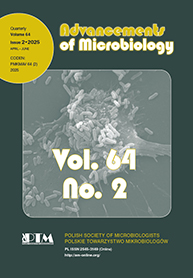Abstract: Diseases transmitted naturally between animals and humans are referred to as zoonoses. Zoonotic diseases are responsible for many pathogenic infections in humans, especially in endemic regions. In recent years, emerging and re-emerging zoonotic infections have become widespread and pose a threat worldwide. Transmitted such bacterial, viral and parasitic infections have been detected in Northen Cyprus over the years. Climate change and human migration are increasing essentially, making such infections potentially more dangerous. To quickly detect these pathogens and limit their spread, it is crucial for the island to control their animal reservoirs. In addition, continued and expanded research is essential for global surveillance.
This review aimed to provide an overview of the etiology of the most recorded zoonotic diseases in Northen Cyprus, their impact on human health, and measures to control their spread better.
All posts by Anna Białecka
Abstract: Gram-negative bacilli Klebsiella pneumoniae are among the most important pathogens responsible for healthcare-associated infections (HAIs). These bacteria often have high pathogenic and epidemic potential, contributing to infection outbreaks worldwide. K. pneumoniae is part of the natural microbiota of humans. At the same time, as an opportunistic microorganism, when the host organism is weakened, it can cause serious infections such as pneumonia, urinary tract infections, septic infections and intra-organ abscesses. Widespread distribution in nature and exceptional adaptability provide K. pneumoniae with the opportunity to master new niches in the hospital environment, which poses a threat to hospitalized patients. Also, the bacteria are increasingly causing life-threatening infections in the non-hospital environment. The pathogenicity of K. pneumoniae is determined by the presence of many virulence factors such as capsular polysaccharide (CPS, K antigen), lipopolysaccharid (LPS, O antigen), fimbrial and non-fimbrial adhesins, siderophores (aerobactin, enterobactin, salmochelin and yersiniabactin), heat-stabile and heat-labile enterotoxins, cytotoxins and biofilm-forming ability. Currently, hypervirulent strains of K. pneumoniae (hvKp) equipped with new virulence traits constitute a significant danger. The paper presents these bacteria concerning the global threat arising from the dynamic spread of hvKp strains in hospitals in Poland and worldwide.
Abstract: Transplantology is a branch of medicine that is developing rapidly. Transplanted whole organs or segments of organs may be recovered from either living or deceased donors. New methods of preserving transplanted solid organs, including the kidney, liver, heart, lung, and pancreas, as well as tissues, such as the cornea and skin, are being developed. Preservation fluid, which is used to perfuse and store the donated organ or tissue, should reduce biological deterioration of organs and tissue, attenuate ischemia/reperfusion-induced cell/tissue injury, and protect against damage. Lowering the storage temperature of organs significantly reduces the risk of damage. Efforts are also made to shorten the time between collecting the organ or tissue from the donor and transplanting it in the recipient. However, during transplantation, the recipient may become infected, primarily with bacteria and fungi. Infections of organ recipients occur most often due to unhygienic organ collection, improper handling and transport, and inappropriate preservation conditions, especially contamination of preservation fluid. The literature on contamination of organ preservation fluid and infections in graft recipients is very diverse, both in terms of the isolated bacterial and fungal species and the number of incidents. A large percentage of contaminating microorganisms belong to the generally non-pathogenic skin microbiota, but there are also cases of multidrug-resistant bacteria. Besides, the transplanted organs themselves may pose a danger. They may contain latent microorganisms, mainly viruses and parasites, that could be activated in a patient who has been subjected to immunosuppression to reduce the risk of organ rejection.
Abstract: The uricase enzyme yields allantoin, hydrogen peroxide, and carbon dioxide by catalyzing the oxidative opening of the purine ring in the urate pathway. This enzyme is important for biochemical diagnosis and reduces toxic urate accumulation during various diseases (hyperuricemia, gout, and bedwetting). Direct urate oxidase injection is recommended in renal complications-associated gout and to prevent chemotherapy-linked hyperuricemia disorders. Thus, uricase is a promising enzyme with diverse applications in medicine. Microbial production of uricase is featured by high growth rates, cost-effective bioprocessing, and easy optimization of the medium. Microbes produce the enzyme extracellular or intracellular. Extracellular uricase is preferred for biotechnological applications as it minimizes time, effort, and purification processes. This review provides insights into uricase-producing microbes, bacterial uric acid degradation pathways, degrading enzymes, and uricase-encoding genes.
Furthermore, aspects influencing the microorganisms’ production of the uricase enzyme, its activity, and its purification procedure are also emphasized. Cell disruption is mandatory for intercellular uricase production, which elevates production costs. Therefore, extracellular uricase-producing microbial strains should be investigated, and production factors should be optimized. Future techniques for obtaining extracellular enzymes should feature reduced time and effort, as well as a simple purification methodology. Furthermore, uricase gene-carrying recombinant probiotic microorganisms could become an effective tool for gout treatment.
Abstract: Genetic, endocrine and immunological disorders, anatomical defects in the reproductive tract, certain chronic diseases, toxic substances, or advanced age of the mother are most cited among the main causes of pregnancy loss at various stages. However, the cause of miscarriage or preterm labor in some cases remains unclear. Determination of the etiology about these clinical conditions may reduce the rate of reproductive failure. Similarly, the etiology of other obstetric disorders, such as preeclampsia or postpartum hemorrhage, has not been fully explained. One of the postulated and still under-researched causes of these disorders may be dysbiosis within the reproductive tract. A disturbed microbial balance is not always associated with the presence of an acute infection with clear clinical symptoms. Dysbiosis in conjunction with other pathophysiological factors may increase the risk of the mentioned clinical conditions. The aim of this paper is to show the information indicating the existence of a correlation between dysbiosis and an increase in the risk of obstetric disorders. Further analysis is also required to clarify the mechanism of the effect of dysbiosis on the disruption of metabolic and biochemical processes within the reproductive system during pregnancy.

